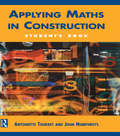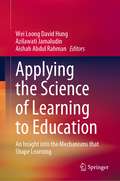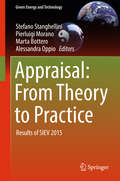- Table View
- List View
Applying Guiding Principles of Effective Program Delivery
by Kerry R. WillsWhile today's programs continue to grow in size and complexity, their success rates remain low. To manage programs effectively in this environment, project managers and program managers must take a consultative approach that applies a core set of guiding principles across every function of the program. This book explains what it means to take a consultative approach. Instead of focusing on specific program management techniques, it covers the guiding principles required to make those techniques effective-making it applicable to any program in any industry.
Applying Landscape Ecology in Biological Conservation
by T. T. Forman Kevin GutzwillerThis book provides a current synthesis of principles and applications in landscape ecology and conservation biology. Bringing together insights from leaders in landscape ecology and conservation biology, it explains how principles of landscape ecology can help us understand, manage and maintain biodiversity. Gutzwiller also identifies gaps in current knowledge and provides research approaches to fill those voids.
Applying Lean Six Sigma in the Pharmaceutical Industry
by Bikash ChatterjeeBikash Chatterjee emphasizes the criticality of applying the principles of Lean and Six Sigma within the paradigm of the drug development process. His guide to operational excellence in the pharmaceutical and biotech industries is a focused summary of the application of Lean Six Sigma theory to the regulated life sciences. From molecule discovery to the application of PAT Applying Lean Six Sigma in the Pharmaceutical Industry will highlight the importance of framing these initiatives within the key deliverables of drug development manufacturing and quality. Challenging conventional wisdom the author offers a quality and efficiency perspective as a foundation for the principles of Quality by Design, PAT and the new philosophies underlying Process Validation. Each chapter includes discussion around the considerations for applying Lean manufacturing and Six Sigma principles and their tools, culminating in a case study to illustrate the application. The book is organized to reflect the major work centers involved in the drug development lifecycle. Each chapter is stand-alone but together they illustrate the necessary synergy between Lean, Six Sigma and compliance sensibilities required to be successful in the pharmaceutical industry. These design, manufacturing and management techniques are not without their challenges. Bikash Chatterjee's book offers the roadmap for an industry that is struggling to reinvent many of its development and business processes.
Applying Lean Six Sigma in the Pharmaceutical Industry
by Bikash ChatterjeeBikash Chatterjee emphasizes the criticality of applying the principles of Lean and Six Sigma within the paradigm of the drug development process. His guide to operational excellence in the pharmaceutical and biotech industries is a focused summary of the application of Lean Six Sigma theory to the regulated life sciences. From molecule discovery to the application of PAT Applying Lean Six Sigma in the Pharmaceutical Industry will highlight the importance of framing these initiatives within the key deliverables of drug development manufacturing and quality. Challenging conventional wisdom the author offers a quality and efficiency perspective as a foundation for the principles of Quality by Design, PAT and the new philosophies underlying Process Validation. Each chapter includes discussion around the considerations for applying Lean manufacturing and Six Sigma principles and their tools, culminating in a case study to illustrate the application. The book is organized to reflect the major work centers involved in the drug development lifecycle. Each chapter is stand-alone but together they illustrate the necessary synergy between Lean, Six Sigma and compliance sensibilities required to be successful in the pharmaceutical industry. These design, manufacturing and management techniques are not without their challenges. Bikash Chatterjee's book offers the roadmap for an industry that is struggling to reinvent many of its development and business processes.
Applying Machine Learning for Automated Classification of Biomedical Data in Subject-Independent Settings (Springer Theses)
by Thuy T. PhamThis book describes efforts to improve subject-independent automated classification techniques using a better feature extraction method and a more efficient model of classification. It evaluates three popular saliency criteria for feature selection, showing that they share common limitations, including time-consuming and subjective manual de-facto standard practice, and that existing automated efforts have been predominantly used for subject dependent setting. It then proposes a novel approach for anomaly detection, demonstrating its effectiveness and accuracy for automated classification of biomedical data, and arguing its applicability to a wider range of unsupervised machine learning applications in subject-independent settings.
Applying Maths in Construction
by Antoinette Tourret John HumphreysThis book and its accompanying Teacher's Pack are the result of a project, supported by the Nuffield Foundation, to provide flexible learning materials for the Basic Application of Number core skill for both the NVQs and GNVQ in construction and the construction crafts. The student book uses a unique approach to explain how mathematical principles apply to construction tasks. Each chapter forms an individual construction project and uses the full range of number skills from the fundamentals of addition and subtraction to statistics, trigonometry and technical drawing. Successfully completed projects provide the student with the required portfolio of evidence for their course. Notes throughout the text refer the student to the relevant module in the Teacher's Pack, which contains assessments, tests and detailed explanations of the number skills needed to complete the projects.
Applying Maths in Construction
by Antoinette Tourret John HumphreysThis book and its accompanying Teacher's Pack are the result of a project, supported by the Nuffield Foundation, to provide flexible learning materials for the Basic Application of Number core skill for both the NVQs and GNVQ in construction and the construction crafts. The student book uses a unique approach to explain how mathematical principles apply to construction tasks. Each chapter forms an individual construction project and uses the full range of number skills from the fundamentals of addition and subtraction to statistics, trigonometry and technical drawing. Successfully completed projects provide the student with the required portfolio of evidence for their course. Notes throughout the text refer the student to the relevant module in the Teacher's Pack, which contains assessments, tests and detailed explanations of the number skills needed to complete the projects.
Applying Multiple-Reaction Stoichiometry to Chemical Reactor Modelling (Synthesis Lectures on Chemical Engineering and Biochemical Engineering)
by Guillermo Fernando Barreto Carlos Daniel LuziThis book delves into the realm of Chemical Reaction Engineering (CRE) by showcasing the practical application of multiple-reaction stoichiometry. The authors critically assess various approaches commonly taught in undergraduate CRE courses to establish the relationships between changes in chemical species. In doing so, they propose an innovative conceptual alternative that is specifically tailored for undergraduate lectures. The book carefully selects composition measures that effectively harness the power of stoichiometric relationships in elementary reacting systems and models, which are typically covered in these courses. Going beyond the basics, it also offers a profound discussion on the value of chemical stoichiometry for tackling more intricate reaction systems and detailed models. Moreover, the book presents a simplified procedure that minimizes the reliance on complex linear algebra techniques, making the book accessible to a wider range of readers.
Applying Physical Ergonomics to Modern Ship Design
by Alexander Arnfinn OlsenThis book combines and summarizes the myriad rules, regulations, guidance, and guidelines that pertain to the human factor element of vessel design and marine operations. With a focus on physical ergonomics, the book is thoroughly researched and draws on the most current Class rules and industry regulations promulgated by the IMO and other organizations. As such, this book serves as a single point of reference for professionals and students involved in human factors and ergonomics at sea.
Applying Power Series to Differential Equations: An Exploration through Questions and Projects (Problem Books in Mathematics)
by James Sochacki Anthony TongenThis book is aimed to undergraduate STEM majors and to researchers using ordinary differential equations. It covers a wide range of STEM-oriented differential equation problems that can be solved using computational power series methods. Many examples are illustrated with figures and each chapter ends with discovery/research questions most of which are accessible to undergraduate students, and almost all of which may be extended to graduate level research. Methodologies implemented may also be useful for researchers to solve their differential equations analytically or numerically. The textbook can be used as supplementary for undergraduate coursework, graduate research, and for independent study.
Applying Predictive Analytics: Finding Value in Data
by Richard V. McCarthy Mary M. McCarthy Wendy CeccucciThe new edition of this textbook presents a practical, updated approach to predictive analytics for classroom learning. The authors focus on using analytics to solve business problems and compares several different modeling techniques, all explained from examples using the SAS Enterprise Miner software. The authors demystify complex algorithms to show how they can be utilized and explained within the context of enhancing business opportunities. Each chapter includes an opening vignette that provides real-life examples of how business analytics have been used in various aspects of organizations to solve issues or improve their results. A running case provides an example of a how to build and analyze a complex analytics model and utilize it to predict future outcomes. The new edition includes chapters on clusters and associations and text mining to support predictive models. An additional case is also included that can be used with each chapter or as a semester project.
Applying Predictive Analytics: Finding Value in Data
by Richard V. McCarthy Mary M. McCarthy Wendy Ceccucci Leila HalawiThis textbook presents a practical approach to predictive analytics for classroom learning. It focuses on using analytics to solve business problems and compares several different modeling techniques, all explained from examples using the SAS Enterprise Miner software. The authors demystify complex algorithms to show how they can be utilized and explained within the context of enhancing business opportunities. Each chapter includes an opening vignette that provides real-life example of how business analytics have been used in various aspects of organizations to solve issue or improve their results. A running case provides an example of a how to build and analyze a complex analytics model and utilize it to predict future outcomes.
Applying Systemic-Structural Activity Theory to Design of Human-Computer Interaction Systems (Ergonomics Design And Mgmt. Theory And Applications Ser.)
by Gregory Z. BednyHuman�Computer Interaction (HCI) is no longer limited to trained software users. Today people interact with various devices such as mobile phones, tablets, and laptops. How can such interaction be made more user friendly, even when user proficiency levels vary? This book explores methods for assessing the psychological complexity of compute
Applying the Science of Learning to Education: An Insight into the Mechanisms that Shape Learning
by Wei Loong David Hung Azilawati Jamaludin Aishah Abdul RahmanThis book provides an overview of the various 'Science of Learning' (SoL) research projects led by researchers at the National Institute of Education, Nanyang Technological University, Singapore, and international research collaborators. It presents the goals and rationale behind the Science of Learning in Education (SoLE) initiative and examines a spectrum of topics relevant to bolstering our understanding of the science underlying learning. The Science of Learning (SoL) is an advancing field, with proponents extolling its potential impact on educational practice. This book investigates the possible correlations or causal relationships between brain functioning and development, physiology, environment factors, and their impact on learning. It promotes an interdisciplinary approach to understanding biological to behavioural mechanisms of learning that are oriented toward optimizing and maximizing every learner’s potential.
Applying the Scientific Method to Learn from Mistakes and Approach Truth
by Finlay MacRitchieIn its simplest form, the scientific method can be thought of as learning from our mistakes and trying to correct them. True scientists try to think rationally, never adopt dogmatic opinions and are always willing to listen to opposing views. They never claim to know the absolute truth but are relentless in their search for it. In this timely book, the author describes the fundamentals of critical scientific thinking. The book further examines the correct use of the scientific method and how to apply it to current events and scientific topics to obtain honest assessments. Current controversies discussed include climate change and COVID-related lockdowns. Additional Features include: Demonstrates the use of the scientific method to assist with objective analysis of issues. Addresses that induction plays a role but the true method for advancing knowledge is hypothesis-deduction. Explores current hot topics within the framework of the scientific method. Outlines common misunderstandings of the scientific method. Applying the Scientific Method to Learn from Mistakes and Approach Truth is approachable enough for the general public and recommended for university and advanced high school science educators and their students.
Applying the Scientific Method to Learn from Mistakes and Approach Truth
by Finlay MacRitchieIn its simplest form, the scientific method can be thought of as learning from our mistakes and trying to correct them. True scientists try to think rationally, never adopt dogmatic opinions and are always willing to listen to opposing views. They never claim to know the absolute truth but are relentless in their search for it. In this timely book, the author describes the fundamentals of critical scientific thinking. The book further examines the correct use of the scientific method and how to apply it to current events and scientific topics to obtain honest assessments. Current controversies discussed include climate change and COVID-related lockdowns. Additional Features include: Demonstrates the use of the scientific method to assist with objective analysis of issues. Addresses that induction plays a role but the true method for advancing knowledge is hypothesis-deduction. Explores current hot topics within the framework of the scientific method. Outlines common misunderstandings of the scientific method. Applying the Scientific Method to Learn from Mistakes and Approach Truth is approachable enough for the general public and recommended for university and advanced high school science educators and their students.
Appraisal: Results of SIEV 2015 (Green Energy and Technology)
by Stefano Stanghellini Pierluigi Morano Marta Bottero Alessandra OppioThis book documents the state of the art and the emerging operational perspectives in the field of the appraisal discipline. It covers a wide range of topics, including energy efficiency, environmental sustainability, socio-economic evaluation of regional and urban transformations, real estate and facility management, risk management. It also discusses the potential role of appraisal in minimising unexpected consequences; the role of evaluators in urban development projects as well as the contribution of several methodologies with respect to the overall planning and design processes; the need to manage the complexity of the current decision contexts, while at the same time promoting efficient and effective evaluation processes; improving the quality of discussion and communication of the outcomes of evaluation processes; as well as the appropriateness of current regulation and policy regimes (EU, national, regional etc.). It comprises a selection of the best papers presented at the SIEV 2015 conference "Appraisal: Current Issues and Problems", which was held in Bari, Italy, in July 2015, and brought together architects, engineers, urban planners, decision-makers and government representatives.
Appraisal and Selection of Projects: A Multi-faceted Approach
by Utpal K. GhoshProject appraisal is the process of assessing in a systematic way, the viability of a project at its initial ‘idea’ stage when information is minimal, but the decision, whether to go ahead with the project, is important, and this book deals with the principles and practice of such appraisal process. It covers all the financial and economic aspects, including market and technical analysis, environmental appraisal, life cycle costing and SWOT analysis. This book starts with basis of the subject followed by analysis of the project proposals from different perspectives for ascertaining their viabilities, including a brief discussion on uncertainty and risk analysis, important tools, and techniques. This book covers projects in almost all domains, such as engineering, management, medical science and so forth. Focuses on all possible aspects of project appraisal and selection Emphasizes differences from public and private projects in terms of financial and economic evaluations Provides step-by-step methods of analysis of multiple issues involved in the initial appraisal of projects Includes sections on ‘lessons learned and learning from experience’ illustrating applications of the process and implications Covers feasibility analysis, including both technical aspects and financial evaluation This book is aimed at professionals, graduate students in civil and industrial engineering, business management, project management, project appraisal, including entrepreneurs for their start-up projects. Utpal K. Ghosh is a Chartered Engineer, a Fellow of the Institution of Engineers (India), a Member of the Institution of Civil Engineers (UK) and a Member of the Institution of Structural Engineers (UK).
Appraisal and Selection of Projects: A Multi-faceted Approach
by Utpal K. GhoshProject appraisal is the process of assessing in a systematic way, the viability of a project at its initial ‘idea’ stage when information is minimal, but the decision, whether to go ahead with the project, is important, and this book deals with the principles and practice of such appraisal process. It covers all the financial and economic aspects, including market and technical analysis, environmental appraisal, life cycle costing and SWOT analysis. This book starts with basis of the subject followed by analysis of the project proposals from different perspectives for ascertaining their viabilities, including a brief discussion on uncertainty and risk analysis, important tools, and techniques. This book covers projects in almost all domains, such as engineering, management, medical science and so forth. Focuses on all possible aspects of project appraisal and selection Emphasizes differences from public and private projects in terms of financial and economic evaluations Provides step-by-step methods of analysis of multiple issues involved in the initial appraisal of projects Includes sections on ‘lessons learned and learning from experience’ illustrating applications of the process and implications Covers feasibility analysis, including both technical aspects and financial evaluation This book is aimed at professionals, graduate students in civil and industrial engineering, business management, project management, project appraisal, including entrepreneurs for their start-up projects. Utpal K. Ghosh is a Chartered Engineer, a Fellow of the Institution of Engineers (India), a Member of the Institution of Civil Engineers (UK) and a Member of the Institution of Structural Engineers (UK).
Appretur der Textilien: Mechanische und Chemische Technologie der Ausrüstung
by Walter BernardMit der Herausgabe dieses Buches soll eine Lücke in der Fachliteratur ge schlossen werden, die seit längerer Zeit besteht. Die rasch fortschreitende Ent wicklung hat auch in der Textilveredlung ihren Niederschlag gefunden. Vor allem gilt dies für eine Reihe von Arbeiten, welche auf Grund der Einführung der synthetischen Fasern in der Textilindustrie neu sind und sowohl in der Färberei als auch in der Ausrüstung vorgenommen werden. Es war nicht möglich, ein Buch zu verfassen, welches sowohl dem Maschinen bauer als auch dem Appreteur im gleichen Maße nützlich sein kann. Es wurde hier mehr Wert auf die Beschreibung der einzelnen Ausrüstungsverfahren gelegt, und die Konstruktionen der für die einzelnen Verfahren notwendigen Maschinen wurden nur insoweit berücksichtigt, wie es für den normalen Ablauf der Be arbeitung der Textilien notwendig erscheint. Trotzdem hoffe ich, auch dem Maschinenbauer wertvolle Anregungen gegeben zu haben, um bei Neukonstruk tionen rationellere Arbeitsweisen einführen zu können. Ich bin mir klar, daß vor allem der IH. Teil des Buches keineswegs alle Ausrustungsverfahren be inhalten kann, die für die angeführten Textilien möglich sind, und es wäre abwegig, aus den angeführten Ausrustungsgängen eine Verbindlichkeit oder Aus schließlichkeit abzuleiten. Ich danke an dieser Stelle allen Fachkollegen für die wertvollen Hinweise, die sie mir gegeben haben. Vor allem gilt dieser Dank den Herren der Staatl. Textillach- und -Ingenieurschule Münchberg und an deren Spitze Herrn Dir.
An Approach to Improving Decision-Making in Wetland Restoration and Creation
by Mary E. KentulaAn Approach to Improving Decision-Making in Wetland Restoration and Creation succinctly compares populations of natural and created wetlands to determine whether restored wetlands successfully replace wetlands lost to development or other pressures. The book also presents strategies for mitigation of wetland losses, site selection for wetland restoration projects, and assessment of the level of attainable function for restored wetlands. The book is a significant resource for helping wetland professionals, planners, and ecologists formulate decisions affecting the creation and restoration of wetlands.
An Approach to Improving Decision-Making in Wetland Restoration and Creation
by Mary E. KentulaAn Approach to Improving Decision-Making in Wetland Restoration and Creation succinctly compares populations of natural and created wetlands to determine whether restored wetlands successfully replace wetlands lost to development or other pressures. The book also presents strategies for mitigation of wetland losses, site selection for wetland restoration projects, and assessment of the level of attainable function for restored wetlands. The book is a significant resource for helping wetland professionals, planners, and ecologists formulate decisions affecting the creation and restoration of wetlands.
An Approach to Multi-agent Systems as a Generalized Multi-synchronization Problem (Understanding Complex Systems)
by Rafael Martínez-Guerra Juan Pablo Flores-FloresThis book addresses the problem of multi-agent systems, considering that it can be interpreted as a generalized multi-synchronization problem. From manufacturing tasks, through encryption and communication algorithms, to high-precision experiments, the simultaneous cooperation between multiple systems or agents is essential to successfully carrying out different modern activities, both in academy and industry. For example, the coordination of multiple assembler robots in manufacturing lines. These agents need to synchronize.The first two chapters of the book describe the synchronization of dynamical systems, paying special attention to the synchronization of non-identical systems. Following, the third chapter presents an interesting application of the synchronization phenomenon for state estimation. Subsequently, the authors fully address the multi-agent problem interpreted as multi-synchronization. The final chapters introduce the reader to a more complex problem, the synchronization of systems governed by partial differential equations, both of integer and fractional order.The book aimed at graduates, postgraduate students and researchers closely related to the area of automatic control. Previous knowledge of linear algebra, classical and fractional calculus is requested, as well as some fundamental notions of graph theory.
Approaches for Clean Combustion in Gas Turbines (Fluid Mechanics and Its Applications #122)
by Medhat A. Nemitallah Ahmed A. Abdelhafez Mohamed A. HabibThis book focuses on the development of novel combustion approaches and burner designs for clean power generation in gas turbines. It shows the reader how to control the release of pollutants to the environment in an effort to reduce global warming. After an introduction to global warming issues and clean power production for gas turbine applications, subsequent chapters address premixed combustion, burner designs for clean power generation, gas turbine performance, and insights on gas turbine operability. Given its scope, the book can be used as a textbook for graduate-level courses on clean combustion, or as a reference book to accompany compact courses for mechanical engineers and young researchers around the world.



















